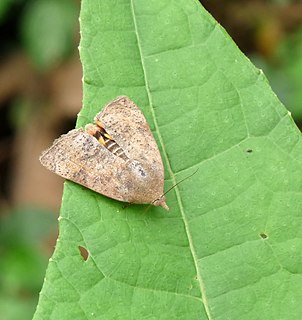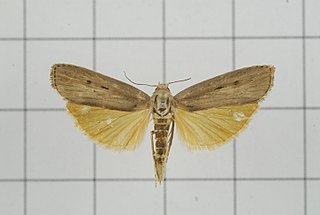Related Research Articles

Meghalaya ; is a state in northeastern India. Meghalaya was formed by carving out two districts from the state of Assam: the United Khasi Hills and Jaintia Hills, and the Garo Hills on 21 January 1972. The population of Meghalaya as of 2016 is estimated to be 3,211,474. Meghalaya covers an area of approximately 22,430 square kilometres, with a length to breadth ratio of about 3:1.

The Pyralidae, commonly called pyralid moths, snout moths or grass moths, are a family of Lepidoptera in the ditrysian superfamily Pyraloidea. In many classifications, the grass moths (Crambidae) are included in the Pyralidae as a subfamily, making the combined group one of the largest families in the Lepidoptera. The latest review by Eugene G. Munroe and Maria Alma Solis, in Kristensen (1999) retains the Crambidae as a full family of Pyraloidea.

The Pyraloidea are a moth superfamily containing about 16,000 described species worldwide, and probably at least as many more remain to be described. They are generally fairly small moths, and as such, they have been traditionally associated with the paraphyletic Microlepidoptera.

Hyblaeidae are the "teak moths", a family of insects in the Lepidopteran order. The two genera with about 18 species make up one of the two families of the Hyblaeoidea superfamily, which in the past has been included in the Pyraloidea. Recent phylogenetic studies find varying relationships of Hyblaeoidea among Ditrysian Lepidoptera: Mutanen et al. (2010) find the superfamily to group either with Pyraloidea, or – more often – with Thyridoidea or butterflies. The results of Wahlberg et al. (2013) and Heikilä et al. (2015) indicate a sister-group relationship with Pyraloidea.

Spilomelinae is a very species-rich subfamily of the lepidopteran family Crambidae, the crambid snout moths. With 4,132 described species in 340 genera worldwide, it is the most speciose group among pyraloids.
In biological taxonomy, circumscription is the content of a taxon, that is, the delimitation of which subordinate taxa are parts of that taxon. If we determine that species X, Y, and Z belong in Genus A, and species T, U, V, and W belong in Genus B, those are our circumscriptions of those two genera. Another systematist might determine that T, U, V, W, X, Y, and Z all belong in genus A. Agreement on circumscriptions is not governed by the Codes of Zoological or Botanical Nomenclature, and must be reached by scientific consensus.

The Phycitinae are a subfamily of snout moths. Even though the Pyralidae subfamilies are all quite diverse, Phycitinae stand out even by standards of their family: with over 600 genera considered valid and more than 4000 species placed here at present, they unite up more than three-quarters of living snout moth diversity. Together with the closely related Epipaschiinae, they are apparently the most advanced lineage of snout moths.

The Phycitini are a tribe of moths of the family Pyralidae.
The Anerastiini are a tribe of moths of the family Pyralidae.

Tirathaba mundella, the oil palm bunch moth, is a species of snout moth. It is found in Malaysia.
Glaphyriinae is a subfamily of the lepidopteran family Crambidae. It was described by William Trowbridge Merrifield Forbes in 1923

Scopariinae is a subfamily of the lepidopteran family Crambidae. The subfamily was described by Achille Guenée in 1854.

Paracymoriza nigra is a moth in the family Crambidae. It was described by Warren in 1896. It is found in India.
Trichophysetis pygmaealis is a moth in the family Crambidae. It is found in India.
Anania profusalis is a moth in the family Crambidae. It was described by Warren in 1896. It is found in India.
Paliga rubicundalis is a moth in the family Crambidae. It was described by Warren in 1896. It is found in India.
Preneopogon barbata is a moth in the family Crambidae. It was described by Warren in 1896. It is found in the Khasia Hills in India.
Pyrausta rubralis is a moth in the family Crambidae. It was described by Warren in 1896. It is found in India.
Omiodes granulata is a moth in the family Crambidae. It was described by Warren in 1896. It is found in India.
Patania verecunda is a moth in the family Crambidae. It was described by Warren in 1896. It is found in India.
References
- ↑ "global Pyraloidea database". Globiz.pyraloidea.org. Retrieved 2014-07-15.
| This Pyraustinae-related article is a stub. You can help Wikipedia by expanding it. |